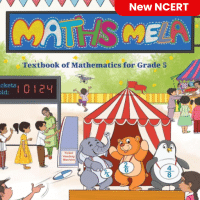Class 5 Exam > Class 5 Questions > ?a)3b)4c)5d)6Correct answer is option ...
Start Learning for Free
स्वामीनाथन की दादी के पास कितने दरियाँ थे?
- a)3
- b)4
- c)5
- d)6
Correct answer is option 'C'. Can you explain this answer?
Verified Answer
?a)3b)4c)5d)6Correct answer is option 'C'. Can you explain this...
स्वामीनाथन की दादी के पास पाँच दरियाँ थीं।
Most Upvoted Answer
?a)3b)4c)5d)6Correct answer is option 'C'. Can you explain this...
Understanding the Problem
To solve the problem accurately, we need to analyze the question and identify the underlying logic or pattern. Since the specifics of the question are not provided, let's assume it involves a numerical sequence, pattern recognition, or a basic mathematical operation.
Identifying the Pattern
- Observe the Sequence: Look for a sequence or pattern in the numbers provided in the question. For example, if it's a series of numbers, check if they increase or decrease in a certain manner.
- Apply Mathematical Operations: Consider applying addition, subtraction, multiplication, or division to determine how the numbers relate to one another.
Calculating the Answer
- Determine the Logic: If the answer is option 'C' (5), it suggests that the underlying logic leads to this particular value.
- Example Calculation: For instance, if the question relates to counting or summing objects or values, ensure that the calculations are accurate:
- If the context is adding groups of items, count each group carefully to arrive at the total of 5.
Conclusion
- Correct Answer Justification: The correctness of option 'C' can be established through the logical steps taken in understanding the problem and applying the appropriate calculations.
- Revisiting the Options: Always revisit the other options (3, 4, 6) to confirm that they do not meet the criteria set by the problem.
In summary, breaking down the question into manageable parts and applying logical reasoning helps clarify why option 'C' is the correct answer.
To solve the problem accurately, we need to analyze the question and identify the underlying logic or pattern. Since the specifics of the question are not provided, let's assume it involves a numerical sequence, pattern recognition, or a basic mathematical operation.
Identifying the Pattern
- Observe the Sequence: Look for a sequence or pattern in the numbers provided in the question. For example, if it's a series of numbers, check if they increase or decrease in a certain manner.
- Apply Mathematical Operations: Consider applying addition, subtraction, multiplication, or division to determine how the numbers relate to one another.
Calculating the Answer
- Determine the Logic: If the answer is option 'C' (5), it suggests that the underlying logic leads to this particular value.
- Example Calculation: For instance, if the question relates to counting or summing objects or values, ensure that the calculations are accurate:
- If the context is adding groups of items, count each group carefully to arrive at the total of 5.
Conclusion
- Correct Answer Justification: The correctness of option 'C' can be established through the logical steps taken in understanding the problem and applying the appropriate calculations.
- Revisiting the Options: Always revisit the other options (3, 4, 6) to confirm that they do not meet the criteria set by the problem.
In summary, breaking down the question into manageable parts and applying logical reasoning helps clarify why option 'C' is the correct answer.

|
Explore Courses for Class 5 exam
|

|
Question Description
?a)3b)4c)5d)6Correct answer is option 'C'. Can you explain this answer? for Class 5 2025 is part of Class 5 preparation. The Question and answers have been prepared according to the Class 5 exam syllabus. Information about ?a)3b)4c)5d)6Correct answer is option 'C'. Can you explain this answer? covers all topics & solutions for Class 5 2025 Exam. Find important definitions, questions, meanings, examples, exercises and tests below for ?a)3b)4c)5d)6Correct answer is option 'C'. Can you explain this answer?.
?a)3b)4c)5d)6Correct answer is option 'C'. Can you explain this answer? for Class 5 2025 is part of Class 5 preparation. The Question and answers have been prepared according to the Class 5 exam syllabus. Information about ?a)3b)4c)5d)6Correct answer is option 'C'. Can you explain this answer? covers all topics & solutions for Class 5 2025 Exam. Find important definitions, questions, meanings, examples, exercises and tests below for ?a)3b)4c)5d)6Correct answer is option 'C'. Can you explain this answer?.
Solutions for ?a)3b)4c)5d)6Correct answer is option 'C'. Can you explain this answer? in English & in Hindi are available as part of our courses for Class 5.
Download more important topics, notes, lectures and mock test series for Class 5 Exam by signing up for free.
Here you can find the meaning of ?a)3b)4c)5d)6Correct answer is option 'C'. Can you explain this answer? defined & explained in the simplest way possible. Besides giving the explanation of
?a)3b)4c)5d)6Correct answer is option 'C'. Can you explain this answer?, a detailed solution for ?a)3b)4c)5d)6Correct answer is option 'C'. Can you explain this answer? has been provided alongside types of ?a)3b)4c)5d)6Correct answer is option 'C'. Can you explain this answer? theory, EduRev gives you an
ample number of questions to practice ?a)3b)4c)5d)6Correct answer is option 'C'. Can you explain this answer? tests, examples and also practice Class 5 tests.

|
Explore Courses for Class 5 exam
|

|
Signup for Free!
Signup to see your scores go up within 7 days! Learn & Practice with 1000+ FREE Notes, Videos & Tests.























